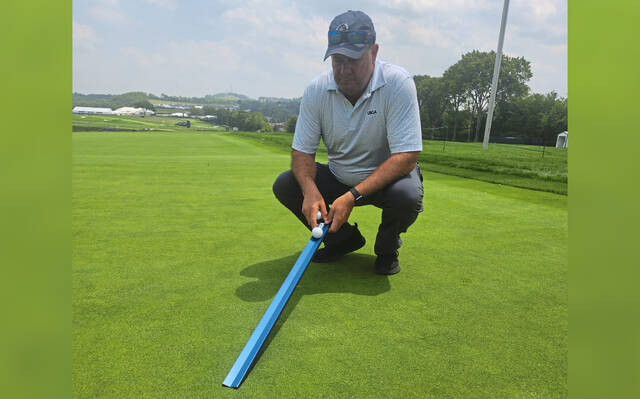What is a Stimpmeter? Learn the term that will be in heavy use at Oakmont
How fast are the greens at Oakmont Country Club?
That question can be answered thanks to the Stimpmeter, a measuring device invented almost 90 years ago by amateur golfer Edward Stimpson soon after attending the 1935 U.S. Open at Oakmont as a spectator. Discussions about the green speeds reportedly led Stimpson to invent the ball-rolling device that became a critical tool for golf course groundskeepers everywhere.
The official Stimpmeter made nowadays by the U.S. Golf Association still works much like Stimpson’s original.
The USGA describes the modern version as an “aluminum bar, 36 inches long, with a V-shaped groove … that extends along its entire length.” Stimpson’s was wooden like a ruler, but the action is the same.
On a level area of the green, place a ball on the designated notch, set the front end of the Stimpmeter on the ground and slowly raise the back end until the ball rolls down the groove and across the putting surface. The ball starts to roll each time at approximately a 20-degree angle.
An accurate reading requires a three-roll series.
All three balls typically come to rest no more than 8 inches apart, according to the USGA, or the results are “of dubious accuracy.” Find the average finishing distance for the three rolls and conduct three more rolls along the same line in the opposite direction. The measured distance in each direction is averaged together to determine the green speed.
The USGA says Stimpmeter readings (informally called the “Stimp”) for most American courses range from 7 to 12 feet. Speed will vary depending on factors such as slope, contour, grass type and weather, with greens often getting firmer, drier and faster throughout the day.
The USGA kept green speeds near 14 for the 2024 U.S. Open at Pinehurst, N.C., according to Golf Digest. Speeds on Oakmont greens are expected to be between 14 and 15.
“One of the most significant aspects of a golf course is the uniformity of its putting greens,” said the USGA, explaining the importance of the Stimpmeter. “Variations in speed, whether from one green to the next or on different parts of the same green, can do more to negate a player’s skill than can ragged fairways or unkempt bunkers.”
The USGA first adopted the Stimpmeter in 1976.
In 2012, the USGA released the current two-sided version with the second side designed for measuring smaller areas.
Chris Harlan is a TribLive reporter covering sports. He joined the Trib in 2009 after seven years as a reporter at the Beaver County Times. He can be reached at charlan@triblive.com.
Remove the ads from your TribLIVE reading experience but still support the journalists who create the content with TribLIVE Ad-Free.

